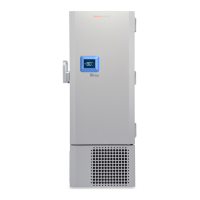7
Thermo Scientific Revco Laboratory Refrigerators Installation and Operation
8 Alarm Systems
8.1 Operating the Alarm
The alarm system is designed to provide visual and audible
warning signals for both power failure and rise in temperature.
The alarm is equipped with a battery backup.
The factory default warm alarm setpoint is 5.5ºC; the default cold
alarm setpoint is 1.5ºC.
The alarm system is activated only when the key switch is turned
to the Alarm On position. The audible warning signal sounds
when there is a power failure or temperature alarm condition, or
when the door is ajar for more than 2 minutes.
The Mute function (pressing the Scan button) allows you to turn
off the audio warning without turning off the visual indicators.
To turn off and reset flashing visual alarms, press and
simultaneously.
There is also a ringback function after approximately 6 minutes if
any alarm condition remains active.
8.2 Local and Remote Alarms
Refrigerators can have either a factory-installed local alarm or an
optional user-installed remote alarm. Operating and testing
procedures are the same for both types of alarm.
The maximum distance between a refrigerator and a remote
alarm depends on the wire gauge used. Refer to Table 5 below.
Table 5. Wire Gauges and Distance to Remote Alarm
8.3 Installing a Remote Alarm (Optional)
Remote alarm terminals are located at the rear of the machine
compartment. The terminals are: Common, Open on Fail
(Normally Closed), and Close on Fail (Normally Open).
1. The remote alarm system has two keyhole slots on the back
to hang the alarm system on the wall. Insert two screws, no
longer than a #12 truss-head type and spaced two inches
apart, into a wall and mount the alarm.
2. Make the following connections:
a. Connect the common terminal on the cabinet switch to
the purple wire on the alarm.
b. Connect the normally closed terminal on the cabinet to
the black (“open on fail”) wire on the alarm. This
connection gives an alarm when the switch contacts open.
3. Plug the alarm system service cord into an electrical outlet.
This alarm is designed for 115V/60 Hz, 115V/50 Hz, or
100V/50 Hz operation.
Note: If you want the alarm signal to sound when the switch
contacts close, connect the normally open terminal on
the cabinet to the red/white (“close on fail”) wire on the
alarm. The purple and red/white wires must be tied
together in this application.
The wiring diagram is attached to the inside of the alarm back
cover.
8.4 Alarm Test
Note: It is important to test your alarm system after any
maintenance operation or temperature control
adjustment.
8.4.1 Theory of Operation
This test procedure applies to both factory-installed built-in
alarms and optional field-installed remote alarms.
During the alarm test, the temperature sensor is artificially heated
and cooled by a tiny, built-in thermoelectric heating and cooling
unit which simulates both warm and cold conditions. The
electronic control module notes the sensor temperature changes
and the control panel displays these changes.
While this alarm testing procedure is very accurate and reliable,
the temperature of the refrigerated space does not change during
the alarm test.
8.4.2 Alarm Test Procedure
Note: This test automatically advances through all steps and
stops.
1. Verify that the current warm and cold alarm setpoints are
within normal ranges (the warm and cold simulations may
not work if the setpoints are set to extreme values).
2. To start the alarm test, press and Scan simultaneously and
hold for five seconds. During the test the main display and
thermometer bulb will indicate simulated (not actual) cabinet
temperature.
3. When simulated temperature exceeds the warm alarm
setpoint, the alarm sounds and the alarm icon on the control
panel illuminates (#10 in Figure 3 on page 4).
4. The temperature display begins to drop. After a few seconds,
the temperature in the display is back in the operating range.
5. The alarm stops. The temperature on the display drops until
the cold alarm sounds.
6. The test is now complete but the alarm continues to sound
until the temperature on the display is back in the operating
range.
If the simulated alarm conditions do not occur during the first 5
minutes of the alarm test, the service (wrench) icon illuminates
and the test is terminated. You can also terminate the test
immediately by turning the key switch to the second (non-alarm)
position. When during the alarm test, the temperature display
does not change or the service icon illuminates, check the sensor
connections.
After an alarm test has terminated, there is a 10-minute delay
before the test can be run again.
Wire Gauge
Total Wire Length
(feet)
Distance to Alarm
1/2 Wire Length
(feet)
20 530 265
18 840 420
16 1,330 665
14 2,120 1,060
12 3,370 1,685

